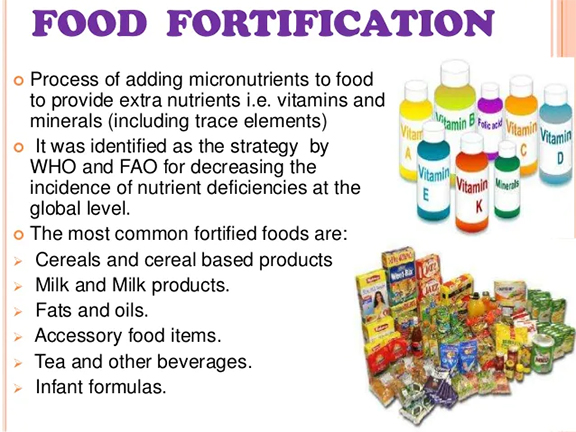Social Justice
Adverse Impacts of Food Fortification
- 03 Aug 2021
- 7 min read
Why in News
Recently, a group of scientists and activists have warned the Food Safety and Standards Authority of India (FSSAI) of the adverse impacts of Food Fortification on health and livelihoods.
- It is a pushback against the Centre’s plan to mandatorily fortify rice and edible oils with vitamins and minerals.
- In order to fight chronic anaemia and undernutrition, the government is making plans to distribute fortified rice through the Integrated Child Development Services and Mid Day Meal Schemes across the country from the year 2021, with special focus on Aspirational districts.
Key Points
- Inconclusive Evidence:
- Evidence supporting fortification is inconclusive and certainly not adequate before major national policies are rolled out.
- Many of the studies which FSSAI relies on to promote fortification are sponsored by food companies who would benefit from it, leading to conflicts of interest.
- Hypervitaminosis:
- Recent studies published in the medical journal Lancet and in the American Journal of Clinical Nutrition which show that both anaemia and Vitamin A deficiencies are overdiagnosed, meaning that mandatory fortification could lead to hypervitaminosis.
- Hypervitaminosis is a condition of abnormally high storage levels of vitamins, which can lead to various symptoms such as over excitement, irritability, or even toxicity.
- Recent studies published in the medical journal Lancet and in the American Journal of Clinical Nutrition which show that both anaemia and Vitamin A deficiencies are overdiagnosed, meaning that mandatory fortification could lead to hypervitaminosis.
- Toxicity:
- One major problem with chemical fortification of foods is that nutrients don’t work in isolation but need each other for optimal absorption. Undernourishment in India is caused by monotonous cereal-based diets with low consumption of vegetables and animal protein.
- Adding one or two synthetic chemical vitamins and minerals will not solve the larger problem, and in undernourished populations can lead to toxicity.
- A 2010 study that showed iron fortification causing gut inflammation and pathogenic gut microbiota profile in undernourished children.
- Cartelisation:
- Mandatory fortification would harm the vast informal economy of Indian farmers and food processors including local oil and rice mills, and instead benefit a small group of multinational corporations who will have sway over a Rs.3,000 crore market.
- Just five corporations have derived most of the benefits of global fortification trends and these companies have historically engaged in cartelising behaviour leading to price hikes.
- The European Union has been forced to fine these companies for such behaviour.
- Decrease Value of Natural Food:
- Dietary diversity was a healthier and more cost-effective way to fight malnutrition. Once iron-fortified rice is sold as the remedy to anaemia, the value and the choice of naturally iron-rich foods like millets, varieties of green leafy vegetables, flesh foods, liver, to name a few, will have been suppressed by a policy of silence.
Food Fortification
- About:
- According to the World Health Organisation (WHO), food fortification is defined as the practice of deliberately increasing the content of essential micronutrients so as to improve the nutritional quality of the food supply and to provide a public health benefit with minimal risk to health.
- It can be noted that biofortification differs from conventional food fortification in that biofortification aims to increase nutrient levels in crops during plant growth rather than through manual means during processing of the crops.
- Types:
- Targeted:
- Food fortification can be done for foods widely consumed by the general population (mass fortification), to fortify foods designed for specific population subgroups, such as complementary foods for young children or rations for displaced populations.
- Market-Driven:
- To allow food manufacturers to voluntarily fortify foods available in the marketplace (market-driven fortification).
- Targeted:
- Procedure:
- The extent to which a national or regional food supply is fortified varies considerably. The concentration of just one micronutrient might be increased in a single foodstuff (e.g. the iodization of salt), or, at the other end of the scale, there might be a whole range of food–micronutrient combinations.
- Government Interventions:
- FSSAI Regulations:
- In October 2016, FSSAI operationalized the Food Safety and Standards (Fortification of Foods) Regulations, 2016 for fortifying staples namely Wheat Flour and Rice (with Iron, Vitamin B12 and Folic Acid), Milk and Edible Oil (with Vitamins A and D) and Double Fortified Salt (with Iodine and Iron) to reduce the high burden of micronutrient malnutrition in India.
- Nutritional Strategy:
- India’s National Nutritional strategy, 2017, had listed food fortification as one of the interventions to address anaemia, vitamin A and iodine deficiencies apart from supplementation and dietary diversification.
- Milk Fortification Project:
- The Milk Fortification Project was launched by the National Dairy Development Board (NDDB) in collaboration with the World Bank and Tata Trusts, as a pilot project in 2017.
- FSSAI Regulations:
Food Safety and Standards Authority of India (FSSAI)
- About:
- FSSAI is an autonomous statutory body established under the Food Safety and Standards Act, 2006 (FSS Act).
- It has its headquarter in Delhi and its administrative Ministry is Ministry of Health & Family Welfare.
- Functions:
- Framing of regulations to lay down the standards and guidelines of food safety.
- Granting FSSAI food safety license and certification for food businesses.
- Laying down procedure and guidelines for laboratories in food businesses.
- To provide suggestions to the government in framing the policies.
- To collect data regarding contaminants in foods products, identification of emerging risks and introduction of a rapid alert system.
- Creating an information network across the country about food safety.





